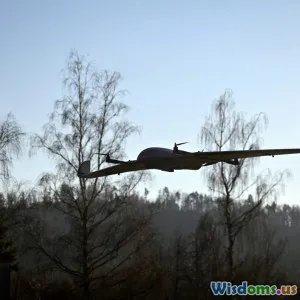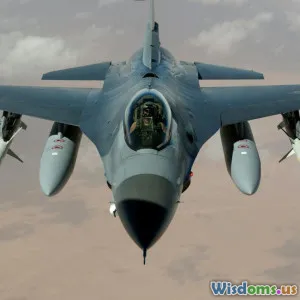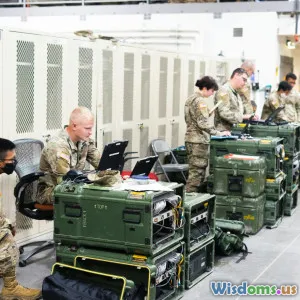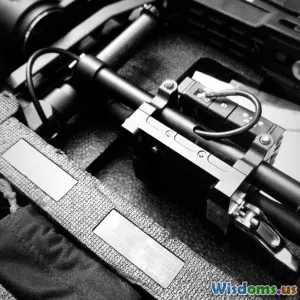
Can Laser Weapons Really Replace Traditional AntiAir Missiles
11 min read Exploring the potential of laser weapons versus traditional anti-air missiles in modern warfare technologies. (0 Reviews)
Can Laser Weapons Really Replace Traditional Anti-Air Missiles?
The evolution of military technology has always been a race to gain supremacy in defense and offense. One of the most captivating developments in recent years is the rise of directed energy weapons, particularly high-energy lasers (HEL). Despite decades of relying on traditional missile technology to defend airspace, many defense circles now ask: can laser weapons truly replace traditional anti-air missiles? This article navigates through the technological landscape, real-world applications, and challenges to understand whether lasers can be the future backbone of aerial defense.
Introduction
For over half a century, anti-air missiles have formed the core of modern air defense systems. These missiles, designed to neutralize enemy aircraft, drones, and incoming threats such as cruise missiles, have proven reliable on countless battlefields. However, as drones become smaller and more numerous, and missile threats evolve, militaries seek novel, cost-efficient, and rapid-response alternatives.
Laser weapons, once the stuff of science fiction, now emerge as a promising technology capable of intercepting threats at the speed of light, with near-instantaneous targeting and a theoretically limitless 'magazine.' But is this enough to replace the tried and true missile systems? Let's dive deeper.
The Fundamentals: How Do Laser Weapons and Anti-Air Missiles Work?
Traditional Anti-Air Missiles
Anti-air missiles operate on propulsion and explosive payloads. Upon detection of an airborne threat, a missile locks onto the target—via radar, infrared, or a combination of guidance systems—and follows a flight path until impact or detonation near the target seam.
Examples include:
- Patriot Missile System (MIM-104): A highly advanced surface-to-air missile used extensively for intercepting ballistic missiles and aircraft.
- S-400 Triumf: Russian-made missile system capable of targeting aircraft, cruise missiles, and ballistic missiles up to 400 km away.
These missiles rely on physical destruction, typically creating explosions that ensure destruction or disablement.
Laser Weapons
Laser weapons, part of directed energy weapons (DEWs), emit focused energy beams, capable of delivering destructive energy at the speed of light.
Key points:
-
How Lasers Work: They generate intense electromagnetic radiation; through focusing optics, the energy heats and causes structural failure or electronic disruption in the target.
-
Types of Effects: From burning through materials, damaging sensors, to disabling electronics.
-
Examples: The U.S. Navy's Laser Weapon System (LaWS) and the U.K.'s Dragonfire demonstrator are current advanced prototypes.
While lasers don’t rely on kinetic impact, their effectiveness depends on power, beam quality, atmospheric conditions, and target characteristics.
Advantages of Laser Weapons Over Traditional Missiles
Cost Efficiency
One of the most touted advantages of laser weapons is the drastically reduced cost per engagement.
- Missile Cost: A single anti-air missile can cost from tens of thousands to over a million dollars.
- Laser Shots: After initial infrastructure investment, each laser shot costs only the electricity needed to power it, often estimated at a few dollars per shot.
This difference matters profoundly in scenarios like countering swarms of drones or projectile artillery bullets where missiles would be prohibitively expensive.
Speed and Precision
Lasers deliver energy at the speed of light, implying immediate engagement as soon as the system locks on the target—far faster than missile flight times.
-
This offers near-instantaneous neutralization of threats, crucial when timing matters.
-
Lasers also provide unparalleled accuracy, reducing collateral damage as the beam can be precisely focused.
Unlimited Ammunition (Virtually)
Traditional missiles come with limited onboard inventory and require logistics and resupply.
- Lasers depend solely on a power supply. While batteries and energy generation limit operational durations, the potential for continuous fire without reloading is significant compared to a finite missile stock.
Low Logistic Footprint
Compared to missiles that require storage, handling of explosives, and transportation to deployment sites, laser systems simplify logistics and reduce battlefield burden.
Challenges and Limitations of Laser Weapons
Despite the promising advantages, several critical challenges prevent lasers from fully replacing anti-aircraft missiles—at least for now.
Power and Energy Requirements
-
High-energy lasers capable of destroying fast-moving aerial targets require substantial power—often in the 100-kilowatt to megawatt class.
-
Mobile platforms like aircraft or ships have limited power generation and storage capacity, so scaling lasers with enough power remains a significant hurdle.
Atmospheric Conditions
-
Lasers degrade significantly with environmental variables:
- Fog, Dust, Rain, Smoke: Scatter and absorb laser beams.
- Thermal blooming: Atmospheric heating affects beam quality and range.
-
This means that on a dusty battlefield, or during adverse weather, laser effectiveness decreases compared to missiles, which are less affected.
Range and Effectiveness Against Agile Targets
While lasers can instantaneously engage targets, their effective destructive range is generally shorter than that of missiles.
Missiles can be launched from tens to hundreds of kilometers away; lasers typically have to be much closer (often within a few kilometers). This places platforms at higher risk.
Small, highly maneuverable targets or those using reflective coatings can also evade the concentrated beam's destructive effect.
Operational and Tactical Integration
-
Laser weapons often serve as complementary systems.
-
Fully replacing missiles would require comprehensive rethinking of air defense doctrine, including early warning, target prioritization, and layered defense systems.
-
Current laser technology is best suited to handle low-cost, easily saturable threats like drone swarms or small boats rather than sophisticated missile volleys.
Real-World Implementations and Testing
U.S. Navy’s Laser Weapon System (LaWS)
The LaWS was deployed on the USS Ponce in 2014 to protect naval vessels from small drones and boats.
-
Demonstrated successful engagements against UAVs at sea.
-
Proven cost advantages: shots at electrical cost vs. thousands of dollars per missile.
U.S. Army’s Directed Energy-Maneuver Short-Range Air Defense (DE-MSHORAD)
Designed to counter drones, rockets, and mortars, the DE-MSHORAD integrates a 50kW laser mounted on a Stryker vehicle.
- This system envisions layered defense, combining lasers for small threats and missiles for others.
International Efforts
-
Israel: Developed Iron Beam, a laser system designed to complement Iron Dome by intercepting rockets and mortars.
-
China and Russia: Reported advances in directed energy weapon prototypes targeting aerial and naval threats.
Despite these prototypes and deployments, laser weapons have not yet replaced missile systems in frontline deployments.
The Future: A Complementary Relationship Rather Than Replacement
Given current technology trajectories, laser weapons are more likely to augment rather than replace traditional missile systems in the near future.
Layered Air Defense Architectures
Modern doctrines advocate multilayered defense:
-
Long-range engagements: Traditional missiles such as Patriot or S-400 take the lead.
-
Short-range in-theater threats: High-energy lasers handle drones, light aircraft, and incoming projectiles in cost-effective ways.
This approach balances cost, coverage, and technology limitations.
Technological Innovations Needed
To make laser weapons a full replacement, breakthroughs required include:
-
Higher power laser sources with reduced size and weight.
-
Improved beam control compensating for atmospheric disturbances.
-
Enhanced power generation/storage solutions for mobile platforms.
Emerging Trends
-
Hybrid systems combining kinetic and energy weapons.
-
AI-assisted targeting to enable faster response and better threat prioritization.
-
Advances in solid-state laser technology promoting rugged, reliable weapons.
Conclusion
Laser weapons represent a revolutionary shift in air defense capabilities, marking the transition from kinetic interception to energy-based destruction. They offer substantial advantages such as near-instantaneous engagement, low per-shot costs, and virtually unlimited ammunition. Yet, their deployment is tempered by real challenges including energy demands, environmental sensitivities, and range limitations.
Traditional anti-air missiles remain indispensable for their long-range, all-weather lethality and proven reliability in diverse combat scenarios. The most pragmatic approach today is to view laser weapons not as replacements but as powerful supplements within modern air defense frameworks.
As research and development progress, we may witness harsher and more frequent conflicts where the synergy of lasers and missiles together repels increasingly complex airborne threats, making the skies more secure than ever.
References:
- U.S. Navy, "Laser Weapon System (LaWS) Fact Sheet," 2014.
- Defense Advanced Research Projects Agency (DARPA), "Directed Energy Weapon Program Overview."
- Jane’s Defence Weekly, "Challenges in Directed Energy Weapon Deployment," 2022.
- Israeli Ministry of Defense, "Iron Beam Laser Defense System Updates," 2021.
- Congressional Research Service, "The U.S. Defense Industrial Base and Directed Energy Weapons," 2023.
This article aims to provide insightful analysis of today’s defense technologies and inspire critical thought about the balance of innovation and practicality in military applications.
Rate the Post
User Reviews
Popular Posts




















